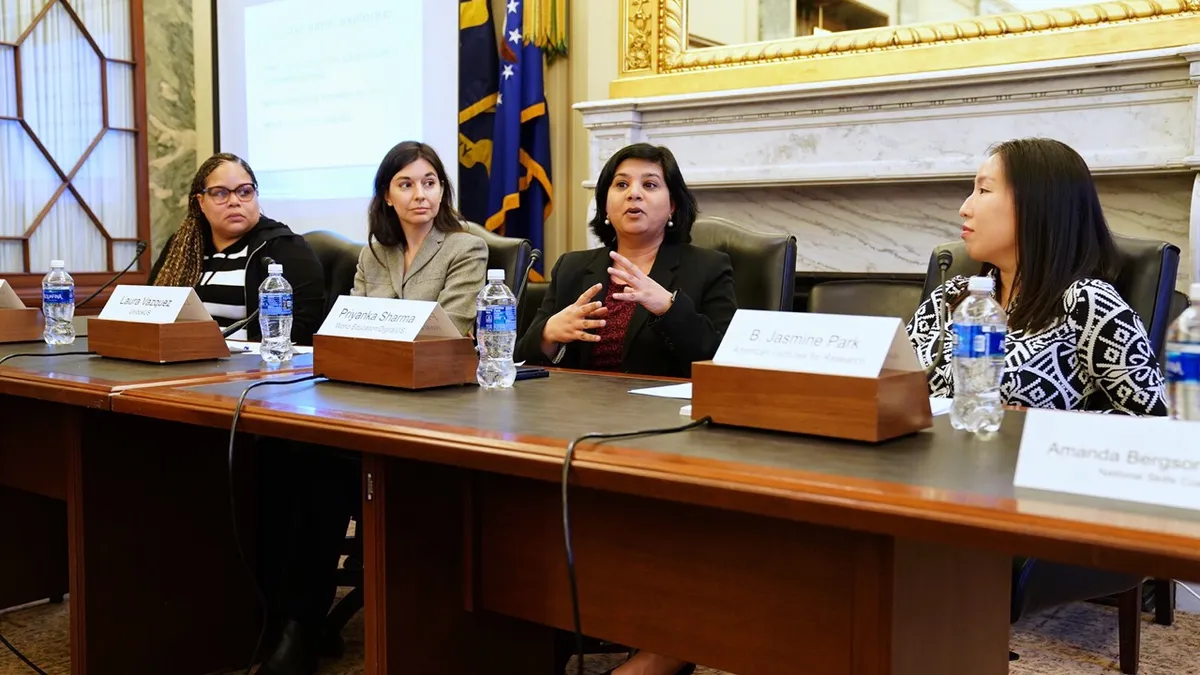Washington — Glaring technology-related skill gaps across the U.S. workforce exist from entry-level workers to managers, according to Amanda Bergson-Shilcock, senior fellow at National Skills Coalition (NSC).
"There are tens of millions of workers in this country who have very limited or no digital skills," Bergson-Shilcock, moderator of the panel discussion "Digital skills and the American Workforce" told an audience of 70 educators, job training providers, congressional staff members and state agency leaders Feb. 5 in the Russell Senate Office Building.
Augmented reality (AR) and virtual reality (VR) are gaining momentum in the employee learning field. Manufacturers are beginning to use AR, and restaurants like Honeygrow and KFC are using VR goggles in for food safety training, Bergson-Shilcock explained.
"Kentucky Fried Chicken has created a virtual reality escape room in which Colonel Sanders will not let you out of the room until you demonstrate that you have mastered the five-step process for properly preparing chicken," she said.
These digital tasks might seem like they’d be easy for someone who owns a smartphone. But even if an employee has segmented digital knowledge, that’s not enough to do their job effectively, Bergson-Shilcock said.
"They might be able to use a cellphone to text a picture, [but] that does not mean that they’re comfortable using that cellphone to do more sophisticated tasks," she added.
Entire industries are feeling the pinch. Panelist Bitnara Jasmine Park, a senior researcher at American Institute for Research (AIR), shared data from the Organization for Economic Co-operation and Development (OECD) adult skills survey, which represents U.S. workers ages 16 to 64 currently employed across all industries. The survey is conducted as part of the Programme for the International Assessment of Adult Competencies, and data is collected in the U.S. under the auspices of the U.S. Department of Education, National Center for Education Statistics.
Park looked at two major industries — manufacturing and health sector. More than 1 in 10 workers are employed in manufacturing, and one third lack key digital skills, she said.
"[Workers in manufacturing] represent about 11% of all U.S. working adults, that is roughly about 60 million people," Park said. "About 5.6 million workers in manufacturing have low digital skills."
Approximately 1 in 7 American workers is employed in the health and social assistance sector, and one-third lack key digital skills. "About 6.7 million workers in the health and social work industry have low digital skills," Park said.
Managers need upskilling, too
Workers across all industries identified as having no digital skills failed one or more of three baseline criteria, including not being able complete four out of six very basic computer tasks, such as using a mouse or selecting text on a screen, according to Park. Men are overrepresented among workers with no digital skills (61%).
In regard to age group, workers ages 45 and up are overrepresented.
"These workers are most likely to be managers in an organization," Park said. "And if you have no digital skills, it would be really difficult to follow the fast-changing pace of the industry."
Workers with no digital skills are represented in all racial and ethnic groups — 44% white, 35% Latino, 15% black, and 4% Asian. About 80% have a high school education or less. However, 7% have bachelor’s degrees.
"What we see here is that low digital skills or no digital skills is not just about the individuals with limited education, but it’s actually a serious issue for even those with more advanced education," Park said.
Age doesn’t determine digital literacy
Park referred to a worker who can "complete simple digital tasks with generic interface and just a few simple steps" as having limited skills. An example is sorting emails that respond to an event invitation into different folders.
"If you think about it, what we’re asking participants to do is very simple," she said.
Nearly one-third of workers with limited digital skills are younger than 35 and men and women are equally likely to be in this group. Fifty percent of workers with limited digital skills are white; 21% black, 20% Latino and 7% Asian. About 53% have a high school diploma and 9% have bachelor degrees.
Low digital skills is also an issue for supervisors.
"How can you train your staff if you don’t have the digital skills to do so?" added Park.
Upskilling efforts
Employers are devising solutions, said Priyanka Sharma, co-director of Digital US, but "nothing at scale" at the moment.
Bergson-Shilcock suggested that advancing federal policy solutions would help achieve digital equity. "Congress has an opportunity to invest in digital skills both in existing legislation that’s up for reauthorization," she said. "The workforce integration and opportunity act, and in specialized legislation like the Digital Equity Act, that, here on the Senate side, is S11-67.
"But at the same time," Bergson-Shilcock continued, "we recognize that it’s not just about investment in digital skills, it’s also about recognizing the state and local examples of where folks are really making great strides. A key example of that is where employers are partnering with education and training providers."
Correction: A previous version of this article had an outdated title for Priyanka Sharma. The story has been updated.






















